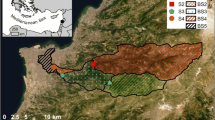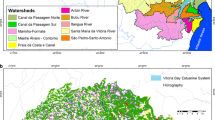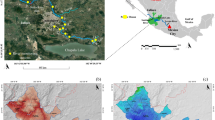Abstract
Many rivers in China and other newly industrialized countries have suffered from severe degradation of water quality in the context of rapid economic growth. An accounting method was developed to investigate the source and mass fluxes of the main contaminants in the Ziya River, a severely polluted and heavily modified river in a semiarid area of the North China Plain, where chemical oxygen demand (COD) and ammonia nitrogen (NH4-N) were the most important indicators of pollution. The results showed that the urban sewage with high concentration of COD and NH4-N dominated the streams, contributing to 80.7 % of the streamflow, 92.2 % of COD, and 94.5 % of NH4-N. The concentrations of COD and NH4-N in streams varied from 24.0–195.0 to 5.8–43.8 mg/L, respectively. Mass fluxes of COD and NH4-N of all pathways were quantified. Much of the polluted water was diverted to irrigation, and some eventually flowed into the Bohai Sea. Installation of adequate wastewater treatment facilities and making strict discharge standards can help improve the water quality. Our findings imply that a simple accounting method provides an extremely well-documented example for load estimation and can be useful for intervention strategies in heavily polluted and modified rivers in newly industrialized countries.









Similar content being viewed by others
Abbreviations
- COD:
-
Chemical oxygen demand
- NH4-N:
-
Ammonia nitrogen
References
Baresel C, Destouni G (2005) Novel quantification of coupled natural and cross-sectoral water and nutrient/pollutant flows for environmental management. Environ Sci Technol 39:6182–6190
Billen G, Garnier J (2007) River basin nutrient delivery to the coastal sea: assessing its potential to sustain new production of non-siliceous algae. Mar Chem 106:148–160
Billen G, Garnier J, Nemery J, Sebilo M, Sferratore A, Barles S, Benoit P, Benoit M (2007) A long-term view of nutrient transfers through the Seine river continuum. Sci Total Environ 375:80–97
Bu HM, Meng W, Zhang Y (2011) Nitrogen pollution and source identification in the Haicheng River basin in Northeast China. Sci Total Environ 409:3394–3402
Canfield DE, Glazer AN, Falkowski PG (2010) The evolution and future of Earth’s nitrogen cycle. Science 330:192–196
Chapra SC, Pelletier GJ, Tao H (2008) QUAL2K: a modeling framework for simulating river and stream water quality, Version 2.11: Documentation and Users Manual
Chen W, Lu S, Peng C, Jiao W, Wang M (2013) Accumulation of Cd in agricultural soil under long-term reclaimed water irrigation. Environ Pollut 178:294–299
DHI Water & Environment, Hørsholm, Denmark (2007) Mike11, version 2007. A modelling system for rivers and channels, Reference manual
Ethier ALM, Mackay D, Toose-Reid LK, O'Driscoll NJ, Scheuttammer AM, Lean DRS (2008) The development and application of a mass balance model for mercury (total, elemental and methyl) using data from a remote lake (Big Dam West, Nova Scotia, Canada) and the multi-species multiplier method. Appl Geochem 23:467–481
Heeb F, Singer H, Pernet-Coudrier B, Qi WX, Liu HJ, Longree P, Muller B, Berg M (2012) Organic micropollutants in rivers downstream of the megacity Beijing: sources and mass fluxes in a large-scale wastewater irrigation system. Environ Sci Technol 46:8680–8688
Jin XC (1998) In: Press ES (ed) Criterion of eutrophication survey on lakes. China Environmental Science Press, Beijing
Lai YC, Yang CP, Hsieh CY, Wu CY, Kao CM (2011) Evaluation of non-point source pollution and river water quality using a multimedia two-model system. J Hydrol 409:583–595
Lessard CR, Poulain AJ, Ridal JJ, Blais JM (2013) Steady-state mass balance model for mercury in the St. Lawrence River near Cornwall, Ontario, Canada. Environ Pollut 174:229–235
Li H, Su BL (2009) Estimation methods of Agricultural non-point source pollution in plain river network area: a review. J Beijing Norm Univ (Nat Sci) 45:662–666
Li WZ, Li XY, Wang HL, Su JJ (2012) Spatial distribution of the main contaminations in aquatic environment in Fuyang River. Acta Sci Circumst 32:2814–2819
Likens GE (2001) Biogeochemistry, the watershed approach: some uses and limitations. Mar Freshwater Res 52:5–12
Liu JH, Qin DY, Wang H, Wang MN, Yang ZY (2010) Dualistic water cycle pattern and its evolution in Haihe River basin. Chin Sci Bull 55:1688–1697
Mackay D, Di Guardo A, Paterson S, Kicsi G, Cowan CE, Kane M (1996) Assessment of chemical fate in the environment using evaluative, regional and local-scale models: illustrative application to chlorobenzene and linear alkylbenzene sulfonates. Environ Toxicol Chem 15:1638–1648
Mathew M, Yao YF, Cao YX, Shodhan K, Ghosh I, Bucci V, Leitao C, Njoka D, Wei I, Hellweger FL (2011) Anatomy of an urban waterbody: a case study of Boston’s Muddy River. Environ Pollut 159:1996–2002
Meng W (ed) (2008) Technique of total amount control for water pollutants in watershed and its application. China Environmental Science Press, Beijing, China
Meng W, Qin YW, Zheng BH, Zhang L (2008) Heavy metal pollution in Tianjin Bohai Bay, China. J Environ Sci 20:814–819
Ongley ED, Zhang XL, Yu T (2010) Current status of agricultural and rural non-point source pollution assessment in China. Environ Pollut 158:1159–1168
Pernet-Coudrier B, Qi WX, Liu HJ, Muller B, Berg M (2012) Sources and pathways of nutrients in the semi-arid region of Beijing Tianjin, China. Environ Sci Technol 46:5294–5301
Peters NE, Shanley JB, Aulenbach BT, Webb RM, Campbell DH, Hunt R, Larsen MC, Stallard RF, Troester J, Walker JF (2006) Water and solute mass balance of five small, relatively undisturbed watersheds in the US. Sci Total Environ 358:221–242
Pieterse NM, Bleuten W, Jorgensen SE (2003) Contribution of point sources and diffuse sources to nitrogen and phosphorus loads in lowland river tributaries. J Hydrol 271:213–225
Qi JY (ed) (2002) Quantity study on non-point source pollution of city, master. Hehai University, Nanjing, pp 1–88
Qiu B, Li PP, Zhong CY, Chen S, Sun DZ (2012) Characteristics and spatial distribution of the rural non-point source pollution in Haihe River Basin. China Environ Sci 32:564–570
Schaffner M, Bader HP, Scheidegger R (2009) Modeling the contribution of point sources and non-point sources to Thachin River water pollution. Sci Total Environ 407:4902–4915
Smith VH, Schindler DW (2009) Eutrophication science: where do we go from here? Trends Ecol Evol 24:201–207
Tao Y, Wei M, Ongley E, Zicheng L, Jingsheng C (2010) Long-term variations and causal factors in nitrogen and phosphorus transport in the Yellow River, China. Estuar Coast Shelf Sci 86:345–351
Vorosmarty CJ, McIntyre PB, Gessner MO, Dudgeon D, Prusevich A, Green P (2010) Global threats to human water security and river biodiversity. Nature 467:555–561
Wang C, Shan BQ (2012) The distribution of aerobic ammonia oxidizing microorganisms in Ziya River, Haihe Basin. Acta Sci Circumst 21:2943–2950
Wool TA, Ambrose RB, Martin JL, Comer EA (2006) Water Quality Analysis Simulation Program (WASP) Version 6.0 Draft: User’s Manual, US Environmental Protection Agency–Region 4
Yang Y, Chen Y, Zhang XL, Ongley E, Zhao L (2012) Methodology for agricultural and rural NPS pollution in a typical county of the North China Plain. Environ Pollut 168:170–176
Yang S, Zhou D, Yu H, Wei R, Pan B (2013) Distribution and speciation of metals (Cu, Zn, Cd, and Pb) in agricultural and non-agricultural soils near a stream upriver from the Pearl River, China. Environ Pollut 177:64–70
Zhang RB, Qian X, Li HM, Yuan XC, Ye R (2012) Selection of optimal river water quality improvement programs using QUAL2K: a case study of Taihu Lake Basin, China. Sci Total Environ 431:278–285
Zhu M (2011) Study on agricultural NPS loads of Haihe Basin and assessment on its environmental impact. Chinese Academy of Agricultural Sciences, Beijing
Acknowledgments
This work was supported by the Major Science and Technology Program for Water Pollution Control and Treatment of China (2012ZX07203003).
Author information
Authors and Affiliations
Corresponding author
Additional information
Responsible editor: Philippe Garrigues
Rights and permissions
About this article
Cite this article
Li, W., Li, X., Su, J. et al. Sources and mass fluxes of the main contaminants in a heavily polluted and modified river of the North China Plain. Environ Sci Pollut Res 21, 5678–5688 (2014). https://doi.org/10.1007/s11356-013-2461-8
Received:
Accepted:
Published:
Issue Date:
DOI: https://doi.org/10.1007/s11356-013-2461-8




